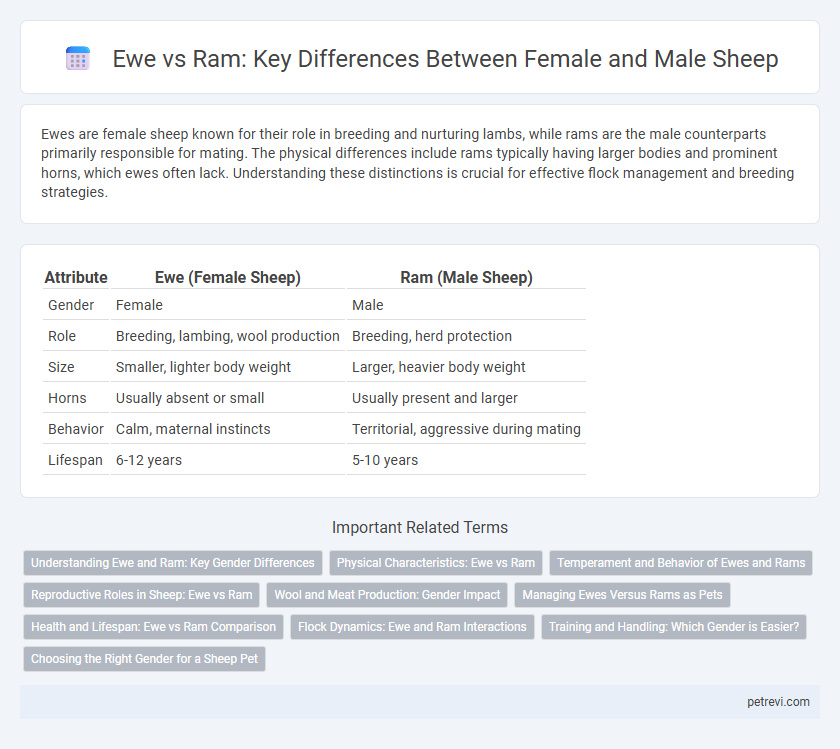Ewes are female sheep known for their role in breeding and nurturing lambs, while rams are the male counterparts primarily responsible for mating. The physical differences include rams typically having larger bodies and prominent horns, which ewes often lack. Understanding these distinctions is crucial for effective flock management and breeding strategies.
Table of Comparison
| Attribute | Ewe (Female Sheep) | Ram (Male Sheep) |
|---|---|---|
| Gender | Female | Male |
| Role | Breeding, lambing, wool production | Breeding, herd protection |
| Size | Smaller, lighter body weight | Larger, heavier body weight |
| Horns | Usually absent or small | Usually present and larger |
| Behavior | Calm, maternal instincts | Territorial, aggressive during mating |
| Lifespan | 6-12 years | 5-10 years |
Understanding Ewe and Ram: Key Gender Differences
Ewes are female sheep primarily responsible for reproduction and nurturing lambs, while rams are male sheep known for breeding and territorial behavior. Ewes generally have a more docile temperament compared to the more aggressive and dominant rams. Understanding these gender differences is essential for effective flock management and breeding practices.
Physical Characteristics: Ewe vs Ram
Ewes typically have a more slender and smaller body frame compared to rams, which exhibit robust and muscular builds. Rams possess thicker necks and larger, curved horns, while ewes often either lack horns or have smaller, less pronounced ones. These distinct physical traits help in easily differentiating between female and male sheep in flocks.
Temperament and Behavior of Ewes and Rams
Ewes exhibit a generally more docile and nurturing temperament, often forming strong social bonds within the flock, which facilitates easier handling and management. Rams display more aggressive and territorial behavior, especially during the breeding season, requiring careful monitoring to ensure safety among the flock and handlers. Understanding these behavioral differences helps shepherds optimize flock dynamics and maintain harmony in mixed-gender groups.
Reproductive Roles in Sheep: Ewe vs Ram
Ewes play a crucial role in sheep reproduction as the female responsible for carrying and nurturing lambs during gestation, typically lasting around 147 days. Rams are the male sheep whose primary reproductive role is to mate with ewes, thereby fertilizing the eggs to initiate gestation. Effective management of ewes and rams ensures successful breeding cycles and optimal flock productivity.
Wool and Meat Production: Gender Impact
Ewes typically produce finer, higher-quality wool due to their genetics and hormonal balance, making them preferable for wool-focused sheep farming. Rams grow coarser wool but contribute significantly to genetic diversity and meat yield, as their larger size results in higher muscle mass and improved carcass quality. Selecting the appropriate gender balance in a flock is crucial for optimizing both wool fiber characteristics and meat production efficiency.
Managing Ewes Versus Rams as Pets
Managing ewes versus rams as pets requires understanding their distinct behaviors and needs. Ewes tend to be calmer and more social, making them easier to handle and suitable for smaller flocks or family environments. Rams often exhibit territorial aggression and require secure fencing and more individualized care to prevent conflicts and ensure safety.
Health and Lifespan: Ewe vs Ram Comparison
Ewes typically exhibit stronger immune responses and tend to have a longer average lifespan of 8 to 12 years compared to rams, which usually live around 6 to 10 years. Rams often experience higher stress levels due to aggressive behavior and mating activities, increasing their susceptibility to injuries and certain diseases. Health management practices for rams should emphasize monitoring for lameness and respiratory issues, while ewe care focuses on reproductive health and parasite control to optimize longevity and well-being.
Flock Dynamics: Ewe and Ram Interactions
Ewes and rams play distinct roles in flock dynamics, with ewes primarily responsible for nurturing lambs and maintaining social cohesion, while rams assert dominance to protect the breeding group and ensure genetic diversity. Rams often exhibit territorial behavior and engage in controlled aggression to establish hierarchy, which impacts flock stability and breeding success. Understanding ewe and ram interactions is crucial for managing reproduction cycles and optimizing flock health.
Training and Handling: Which Gender is Easier?
Ewes generally exhibit calmer behavior, making them easier to train and handle compared to rams, which can display aggressive and territorial tendencies. Training sessions with ewes tend to be more successful due to their more docile and social nature. Understanding these behavioral differences is crucial for effective sheep management and safety during handling.
Choosing the Right Gender for a Sheep Pet
Ewes are ideal for pet owners seeking a calm and nurturing companion, as they tend to be more docile and easier to handle. Rams, on the other hand, often exhibit protective and territorial behaviors, requiring experienced caretakers to manage their aggression and dominance. Selecting the right gender depends on the owner's experience level and desired interaction style, with ewes being better suited for beginners and rams for those prepared to manage stronger personalities.
Ewe vs Ram for Sheep Gender Infographic

 petrevi.com
petrevi.com